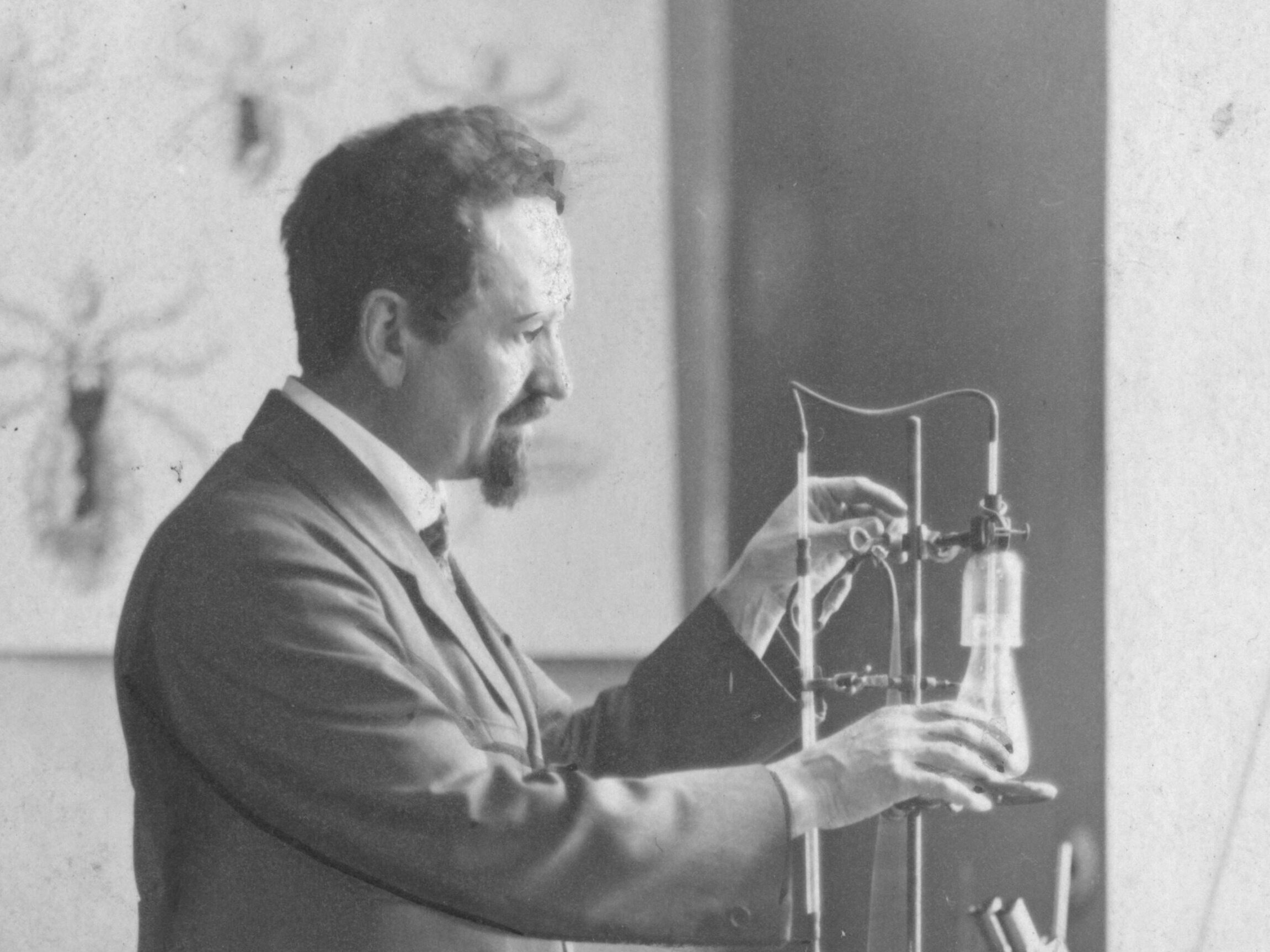“He transformed the symbol of dirt into a life-saving tool.” The extraordinary story of Rudolf Weigl

Rectal infection of lice, feeding them fresh human blood and making them into vaccines. Today, this story may seem unbelievable, but it really happened. And Rudolf Weigl himself, the inventor of the typhus vaccine, saved millions of lives.
“The louse to be infected is held down with thin but strong tissue paper, and then, with the hand under a microscope, the thin tip of a glass syringe is inserted into the rectum of the lice, and the germ suspension is injected. When injected, the louse swells, which can be clearly observed with the naked eye; the germ develops in it” – this is how the procedure of infecting lice in the laboratory of Rudolf Weigl in 1930 was written on the front page of “Kuryer Lek” (supplement to “Ilustrowany Kuryer Codzienny”).
Exactly 27 years later, at the scientist’s funeral, his longtime student and friend, Father Prof. Henryk Mosing said:
Rudolf Stefan Weigl transformed the louse, a symbol of dirt, misfortune and disgust, into a useful object of scientific research and a life-saving tool.
The disease of war and dirt
In order to fully understand the genius and importance of Weigl’s achievements, one must remember that typhoid fever (also known as spotted typhus or rash typhus) once caused the death of millions of people, taking its toll around the world. Typhus itself is one of the zoonoses, i.e. zoonotic diseases. The disease comes in two varieties. We distinguish mouse typhus (aka rat typhus) and European spotted typhus, and the latter has been the cause of historical epidemics. For both types of spotted typhus, the main source of infection is parasites – European typhus is transmitted by head and clothing lice, and rat typhus by rat-feeding fleas.
How dangerous this disease is, a simple comparison with the modern COVID-19 epidemic, used by Lewi Stone, a researcher from Tel Aviv University and RMIT University in Melbourne, suffices. A scientist dealing with typhus epidemic in the ghetto, in an interview quoted on the pages of the Warsaw Ghetto Museum, he said: “Typhus is a less contagious but more deadly disease. Covid-19 kills about 1 percent of those infected, typhus – 20 percent. Typhus is spreading very quickly.”
Although typhus was called the disease of filth and war, the disease did not spare any social group. Today, cases of typhus are recorded only in Africa and Asia. In Europe, the last case of the disease was recorded in the 1960s. It should be added that before the invention of antibiotics, the vaccine was the only effective method of stopping the epidemic.
How Weigl took care of typhus
Rudolf Weigl was born on September 2, 1883 in today’s Czech Republic to an Austrian family. After his father’s death, his mother became involved with a Polish teacher, and Rudolf himself considered himself a Pole until the end of his life and emphasized it many times. He used to say that nationality is not a matter of birth but of choice. And that this choice can only be made once in a lifetime.
He graduated in natural sciences in 1907 at the University of Lviv. He stayed at the university because he wanted to pursue an academic career. Even then, he was interested in typhus, a disease that made the world tremble at the time. World War I is the moment when a young scientist is drafted into the Austro-Hungarian army as a parasitologist (specialist in parasites), and then works in a military hospital in Przemyśl.
And it was the work in the laboratory of the hospital in Przemyśl that was supposed to be a breakthrough for Weigl. The work in the laboratory was supervised by a certain Filip Eisenberg. He considered dealing with typhus a whim and a waste of time, because if the war ended, the epidemic would stop and there would be no place to get infected lice. The quarrel of scientists was supposed to make Weigl come up with an idea how to infect lice. How groundbreaking this thought was, let it be proved by the fact that in order to get infected with typhus, the louse had to suck the blood of an infected person, and yet no one even thought of intentionally infecting people. So Weigl came up with the idea of injecting bacteria (rickettsiae) into the lice through the anus.
Mariusz Urbanek, the author of the biography “Professor Weigl and the lice feeders”, writes about this idea and the argument with Eisenberg:
“- If they don’t want to suck normally, they need it in the d…” Weigl apparently hesitated whether it was appropriate to use a blunt word in front of the professor and his superior and ended differently – … inject into the rear orifice (…) Eisenberg was (…) appalled by Weigl’s words. The young docent decided to save the situation.
“What do you think you can’t?”
He took a thin capillary and, under the microscope, in front of Eisenberg, injected a drop of liquid into the intestine of the lice.
Then everything went smoothly. Because since Weigl had infected lice, he could be working on a vaccine. The scientist dissected an intestine full of bacteria from the lice, ground it in a laboratory mortar, poured phenol and this was the basis for making a vaccine. Weigl tested the first preparations on himself and on guinea pigs.
His laboratory technicians also came to the rescue, although they did it in secret from their boss. One woman took the vaccine and then picked up rickettsial-infected lice. The vaccine did its job and the lab technician did not get sick. Even then, Weigl was in Lwów (the war was over), where he obtained the title of professor.
Rudolf Weigl and thousands of lice feeders
The vaccination campaign in China brought Weigl worldwide fame, because it was there that the vaccine was first used on a mass scale among Belgian missionaries who were decimated by typhus. The Polish scientist’s vaccines were known all over the world, but when another war broke out, something else happened. Thanks to vaccination, many lives have been saved, not only from disease.
You could say that during World War II Weigl became untouchable – everyone knew that his vaccine was needed. Weigl took advantage of this and, despite death threats, did not sign the Reichlist. But most importantly, he was given free rein to hire people at his Typhus and Viruses Research Institute.
And here we come to one of the amazing parts of this story. It took 120 lice to produce one vial of the vaccine. Hence, Weigl employed people as feeders for the thousands of lice that hatched every day in the laboratory (he and his wife were the first feeders). Today it may sound unbelievable, but the feeders had to put wooden boxes (also called coffins) to the body, usually to the thighs, with a dense mesh on one side (like a sieve used for sifting flour). The boxes contained lice, which penetrated through the mesh into the skin of the host. Only healthy and fed lice could be infected in the laboratory.
In this way, thousands of lice feeders worked for Weigl, and his staff – like the professor himself – was untouchable. This protected the feeders from roundups and deportations. The lice feeders were ordinary citizens, but also outstanding scientists and artists. Among them, the poet Zbigniew Herbert and the mathematician prof. Stefan Banach. The scientist and his excellent team knew that they could afford more. Surplus vaccines, carefully hidden from the Germans, were sent to the ghetto in Lwów and delivered to the Warsaw ghetto.
Why Weigl didn’t get the Nobel Prize?
After the war, Professor Weigl went first to Krościenko, and then to Kraków, where he continued his research. Then he moved to the University of Poznań and worked there until his retirement.
In the years 1930-39, Rudolf Weigl was nominated for the Nobel Prize as many as 75 times (in the fields of physiology and medicine). How is it possible that a man who made an important discovery and saved thousands of lives did not receive this most important scientific award? All because of politics. First, Weigl’s candidacy was boycotted by the Germans, then scientists who, paradoxically, accused him of collaborating with the Germans, and after the war, Poland officially withdrew Weigl’s candidacy.
Rudolf Weigl died in 1957 in Zakopane, after a stroke. He was posthumously awarded the Commander’s Cross, the Star of the Order of Polonia Restituta and the Righteous Among the Nations medal.






